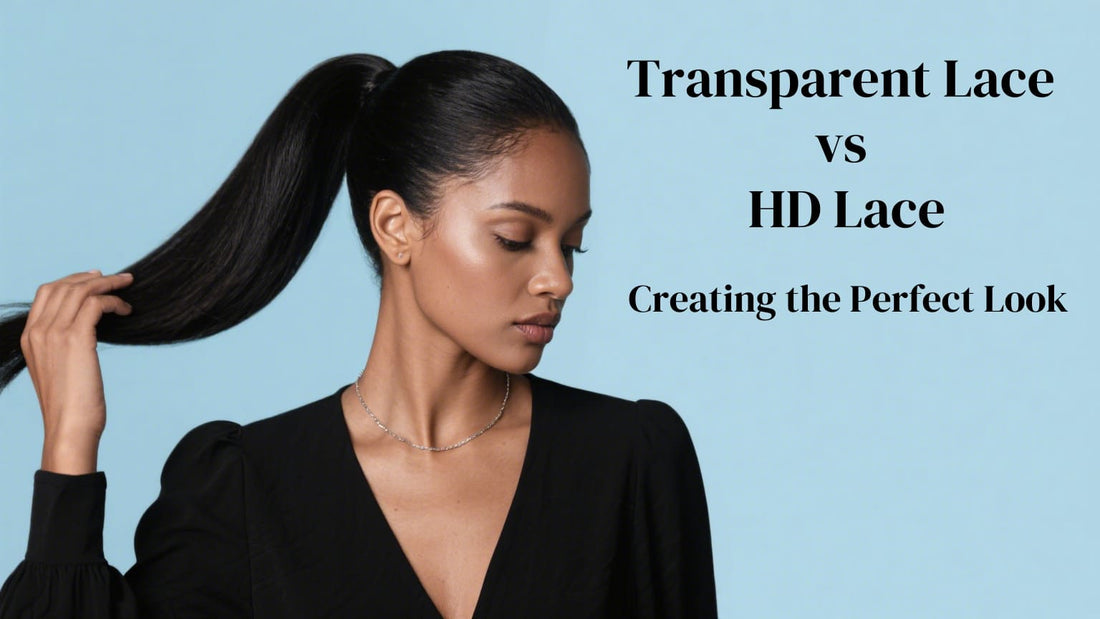
Transparent Lace vs. HD Lace: Creating the Perfect Look
Transparent lace and HD lace form the foundation of any high-quality lace wig, two innovations that have driven significant transformations in the wig industry in recent years. These two lace materials serve as bases onto which human hair is meticulously hand-tied, mimicking the appearance of hair growing naturally from the scalp. While both offer significant advantages over traditional base materials, their unique properties make them suitable for specific preferences, skin tones, and wearing scenarios—essential knowledge for any wig enthusiast before purchasing.
1. What is Transparent Lace?
Transparent lace represents a major breakthrough in wig technology. Made from an extremely thin transparent material, it is designed to blend seamlessly with multiple skin tones. Producing this innovative lace requires special craftsmanship, including removing the unsightly beige or brown hues common in other laces, making it nearly invisible when applied to the skin. This semi-transparent quality makes it particularly suitable for people with light to medium skin tones, creating undetectable wig edges. When properly worn and styled, transparent lace wigs fit comfortably on the head—whether partially pulled back to expose the hairline or fully styled away from the face, maintaining a natural appearance in any hairstyle.
2. Definition of HD Lace: The Premium Choice
HD lace is one of the most distinctive types of transparent lace and a common term in discussions comparing transparent lace and HD lace. This ultra-fine lace is extremely thin and becomes almost invisible when applied to the skin. "HD" stands for "high definition," meaning it is difficult to detect even under close observation or high-definition lenses. The fine mesh structure of HD lace (with smaller and denser pores compared to standard transparent lace) makes it an excellent material for wig production. This structure enhances breathability during the hand-tying process, creating a more natural hair density distribution in the hairline and parting areas.
3. Material Differences: Composition and Structure
A comparative analysis of transparent lace and HD lace reveals significant material differences:
-
Transparent lace typically features a medium-thickness construction and medium-sized mesh patterns, balancing durability and natural appearance.
-
HD lace uses ultra-fine yarns and micro-level mesh pores to form a surface almost indistinguishable from skin. These structural differences significantly impact the wig’s visual effect and breathability: HD lace is renowned for its excellent air circulation, keeping the scalp cool during long-term wear. Despite its delicate appearance, HD lace ensures sufficient strength through special craftsmanship to securely hold hand-tied hair strands.
4. Wearing Requirements and Techniques
The two differ in wearing requirements:
-
While transparent lace requires careful handling (prone to shifting or wrinkling during activities like showering or swimming), its slightly tougher texture offers a higher margin of error during wear.
-
HD lace is more delicate and prone to tearing, often requiring professional application for optimal results. Key points include customization: dying the lace to match specific skin tones, strategically plucking hairs to create a natural hairline, and using adhesives designed for sensitive lace materials. Although HD lace’s thinness allows it to seamlessly conform to the scalp’s contour, additional reinforcement may be needed in high-stress areas.
5. Durability and Maintenance Tips
Understanding their durability and maintenance needs is essential when choosing:
-
Transparent lace generally has a longer lifespan and requires less frequent reapplication or adjustment before showing signs of wear.
-
While HD lace offers superior visual effects, it is more fragile and has a shorter overall lifespan—especially with frequent styling or rough handling. Both laces require professional care: using alcohol-free cleaning products, gentle combing, and storing them in protective containers when not in use. Investing in high-quality lace protection products and following maintenance guidelines can extend the lifespan of both.
6. Visual Performance on Different Skin Tones
A key point of comparison is their adaptability to different skin tones:
-
Transparent lace blends easily with light to medium skin tones but may require additional customization steps like dying on deeper skin tones to achieve a seamless effect.
-
HD lace has universal adaptability, fitting all skin tones from the palest to the deepest with minimal adjustment. Its ability to mimic skin texture makes it suitable for those with uneven skin tone or pigmentation issues, reducing the likelihood of the lace being detected. While both can be dyed to enhance blending, HD lace’s "invisible melt" property creates a more realistic hairline regardless of skin tone.
Recommendation
YiWigs delivers exceptional quality through professional manufacturing processes, ensuring its lace front and full lace wigs exhibit a natural and flawless appearance. With customization options like pre-plucked hairlines, bleached knots, and baby hair details, their premium lace collections offer comfortable, durable, and realistic wigs made from the highest-quality transparent and HD lace materials, suitable for all clients.
